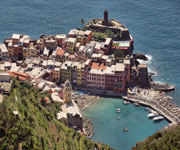The eastern Ligurian Riviera between Cinque Terre and Porto Venere is a cultural site of outstanding value, representing the harmonious interaction between man and nature to produce a landscape of exceptional scenic quality that illustrates a traditional way of life that has existed for 1,000 years and continues to play an important socio-economic role in the life of the community.The area covers some 15 km along the extreme eastern end of the Ligurian coast, between Levanto and La Spezia. It is a very jagged, steep coastline, which the work of man over the millennia has transformed into an intensively terraced landscape so as to be able to wrest from nature a few hectares of land suitable for agriculture, such as growing vines and olive trees.

Continent: Europe
Country: Italy
Category: Cultural
Criterion: (I)(IV) (V)
Date of Inscription: 1997
Inhospitable nature
The human communities have adapted themselves to this seemingly rough and inhospitable nature by building compact settlements directly on the rock, with winding streets. The general use of natural stone for rooting gives these settlements a characteristic appearance. They are generally grouped round religious buildings or medieval castles.
 |
| Cinque Terre |










0 comments:
Post a Comment